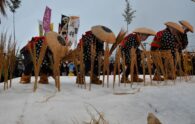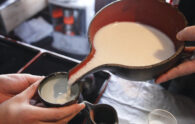Welcome to the town of Nishiwaga
Nishiwaga is a town in Iwate, with a population of 5,363 and an area of 590.74 km2, that is famous for its abundant nature, ranging from wild plants such as bracken, to wildlife, such as deer and bear. The town’s mountainous terrain makes it the perfect place for outdoor activities, including mountain climbing and SUP (stand up paddle board) on lakes. Asides from the town being blessed with nature, it’s also famous for having the most annual snowfall out of any municipality in Iwate Prefecture, with a yearly average of about 900 cm in the town’s Yuda district. Nishiwaga is just about an hour drive from the proposed ILC site, and neighbors Kitakami City.
*The population and snowfall statistics refer to the time the article is published.
Map showing Nishiwaga in relation to the ILC site
Nishiwaga’s winter scenery
The author, next to a huge snow-wall in Nishiwaga.
The Waga River
Snow-buried rice fields in Nishiwaga
While having to deal with the snow all throughout winter (which, in Iwate, lasts for about half the year) is in no way easy, the town also holds a couple events to celebrate the snowfall. In addition to a snow light festival, the town annually holds a snowball tournament (known as Yukigassen in Japan), the “Hot Yuda North Japan Yukigassen Tournament”. Since moving to Iwate from the US, I’ve had the honor to compete in the tournament twice, in 2019 and 2020. While Nishiwaga’s snowball tournament is usually held for two days in January, it unfortunately had to be canceled in 2021 due to the Covid-19 pandemic.
About the sport: Yukigassen
If you’ve never heard of snowball fighting as a sport before, the idea might sound confusing at first. While snowball fights often refer to the games played by children, Japan’s Yukigassen has been turned into an official sport, and even has tournaments held in several countries throughout the world. Avid Yukigassen fans even hope to turn the sport into an official Olympic game someday.
A match at the Hot Yuda North Japan Yukigassen Tournament.
To compare Yukigassen to other common games, it could be explained as a combination of dodgeball—only with snowballs—and capture the flag. Teams from around the prefecture, and even the country come to compete in matches that are set up as 7 versus 7. The scoring system allows several paths to victory, with two main ways to win: to get every member of the opponent team out by hitting them with a snowball, or to capture the opponent team’s flag. Each match consists of 3 rounds, where the team with the highest total points wins and moves on to face more competitors. When I participated, there were local products as prizes for the grand winners, such as high-class meat.
Strategy is key to victory. This photo shows a team from Hiraizumi—including the mascot for their World Heritage Site, Kerohira—huddled together before their next match starts.
My team and our flag. Our team name is “Sandanbara”, which translates to ‘triple belly’, inviting a similar image to a double chin, only with a stomach. Despite our silly name, which gets some laughs out of kids who come to see the tournament, we do our best to put up a good fight.
While the matches themselves are physically demanding, a lot of energy also goes into making the snowballs before the matches even start. Teams are responsible for making their own snowballs, by shoveling and packing snow into trays, and stomping them to harden the snowballs.
These are the devices used to form the snowballs. Each team is allowed 90 snowballs per match set. There’s a limited amount of time to make them, so teams need to rush to make them. Many teams also have ally teams so they can help each other make snowballs. As such, when you consider the time spent helping out ally teams, more time goes into making snowballs than actually participating in the matches.
The Yukigassen Snowball.
By the time the snowballs are formed, the phrase “ice-ball” would be much more fitting, as they end up harder and heavier than a baseball. Once the snowballs have been carved out after being stomped into the tray, members reinforce each snowball by hand-packing it, to make sure they won’t fall apart while it’s being thrown through the air. Because the snowballs are essentially ice-balls, they tend to be too slippery to hold with normal snow gloves. Many compete with gardening gloves for the grip, or even their bare hands. I have even had team members mention that they damaged their skin while preparing the snowballs, to the point that their electronic devices won’t register their finger prints anymore. As one can imagine, it’s excruciatingly painful to get hit by these snowballs. I have also been unlucky to be left with a couple bruises which lasted for months after the tournament.
Packing the snowballs by hand.
In addition to the withstanding the pain that comes from getting hit with these monstrous snowballs, teams also have to bear the freezing cold, as all of the matches and preparations are done outside. I remember my first time participating in the tournament—it was about -10 degrees Celsius all day, so despite my nerves, I was desperate for my match to start so I could get warmed up from running around the court!
Getting a warm bite to eat at the food stalls which come to the competition is a great way to stand the cold.
Enjoy the town during the tournament!
While having to put up with the pain and cold might not sound the most appealing, the exhilarating sport, team comradery and lovely town of Nishiwaga is sure to make the snowball tournament a highlight of every participant’s winter. Complimenting Nishiwaga’s harsh winter, the town is abundant with hot springs. As such, most of the Yukigassen participants stay in hot spring inns throughout the town—the perfect way to relax after a fulfilling day of matches.
Relaxing at the natural hot spring foot bath at the Hot Yuda Station, while enjoying ice cream made with the town’s specialty: Yuda Milk. Nishiwaga is so full of hot springs, there’s even a hot spring inside of the station building!
Even for those who don’t compete in the tournament, Nishiwaga is the perfect spot to experience nature and a winter wonderland in Iwate. If you’re interested in participating, then gather your friends to make a team, and start practicing—I hope to see you in a match!
Japanese
西和賀町へようこそ岩手県西和賀町は人口5,363人、面積590.74㎢で、ワラビなどの山菜に恵まれており、また、熊や鹿の野生動物などが生息し、自然豊かなまちとして知られております。町は山間部であるため、登山や湖でのSUP(スタンドアップパドルボード)など、たくさんのアウトドア体験が出来ます。自然豊かなだけでなく、岩手県で一番積雪量の多いまちであり、まちの湯田地区では、年間平均で約900㎝の降雪があります。西和賀町は北上市の隣町で、ILC建設候補地から車だと1時間ぐらいで行けるところです。
*人口と積雪量は記事投稿時点のデータとなっています。
[写真]
西和賀町とILC建設候補地の地図
西和賀の冬景色
[写真]
私が町内にある雪壁の前で立っている写真
[写真]
和賀川
[写真]
雪が積もった田んぼ
岩手県では半年ぐらい続く冬の間、豪雪に対応しなければならないので、大変な時もたくさんありますが、西和賀では雪を祝う行事もあります。雪あかりのお祭りの他に、西和賀町では、毎年「ほっとゆだ北日本雪合戦大会」が開催されています。アメリカから岩手県に引っ越してきてから、2回この大会に参加する事が出来ました。普段は1月に2日間開催されますが、2021年の大会はコロナウィルスの影響で残念ながら中止となりました。
「雪合戦」について
スポーツとしての雪合戦について聞いた事がない人にとっては、最初は想像が付かないかもしれません。雪合戦と聞くと子供の遊びを思い浮かべるかもしれませんが、日本では雪合戦が公式のスポーツとなっており、現在、世界各国でも大会が開催されるようになっています。熱心な愛好家たちは、いつか雪合戦がオリンピック公式種目に認められる事を期待しています。
[写真]
ほっとゆだ北日本雪合戦大会の写真
雪合戦は、他のスポーツと比べると、ドッジボール(ただし、使用するのはボールの代わりに雪球)と、キャプチャー・ザ・フラッグ(旗取りゲーム)を組み合わせたようなスポーツと言えます。県内、国内からチームが集まり、7人対7人の大会に参加します。得点制度によりいくつかの勝ち方がありますが、一般的に二つの方法があります。一つ目はドッジボールみたいに、相手チームのすべての競技者に雪球を投げ当ててアウトする事、二つ目は相手チームのチームフラッグを抜く事です。3セットマッチとなっており、一番点数が取れたチーム、あるいは2セット先取出来たチームが勝ちとなり、次の試合に進む制度になっています。私が参加した時は、入賞者への賞品として高級肉などの地元の名産品が用意されていました。
[写真]
試合に勝利するためには戦略が必要です。写真は、世界遺産平泉PRキャラクター「けろ平」を含む平泉町のチームが試合の前に戦略を立てている様子です。
[写真]
チームメンバーと一緒に立って、フラッグを持っています。私たちのチーム名は、「三段腹」で、二重顎みたいなお腹がイメージなのです。見に来てくれた子供たちを少し笑わせるようなふざけたチーム名ですが、大会で精一杯戦いました。
試合に参加すると体力を消費し疲れますが、試合開始前も雪球作りで体力を使います。各チームは、球形の入ったトレイに雪をシャベルで入れて、足で踏み固めて自分たちの雪球を作ります。
[写真]
こちらの機械を使い、試合開始前に雪球を作らなければなりません。試合では、1セットにつき各チーム90個の雪球が使えます。雪球を作れる時間が制限されているので、試合の前に各チームが必死で作ります。他のチームと仲間になり、試合のない仲間のチームに雪球作りの協力をお願いする場合もあります。仲間チームへの協力を含めると、実際に試合に参加している時間よりも雪球作りに費やす時間の方が長いです。
[写真]
雪合戦の雪球
雪球が出来上がった時、雪球は野球ボールよりも硬くて重くなるので、「氷球」という言葉の方が合っているのではないかと思います。機械を使って雪球の形が出来たら、投げている途中で崩れないように参加者たちが手で更に固めます。氷球のようになるため、滑りやすく、普通の雪用手袋では持てなくなります。しっかりと持てるように、多くの参加者が作業用の手袋や手袋無しで参加しています。雪球のせいで肌を痛めて、スマートフォンなどの指紋認証が反応しなくなったと言っていたチームメンバーもいます。ご想像どおり、雪球に当たると、とんでもないほど痛いです。また、大会の後にはアザが数か月も残っていました。
[写真]
雪球を箱に詰める様子
雪球に当たる時の痛みだけでなく、全ての試合と準備が外で行われるため、競技者たちは大変な寒さにも耐えなければなりません。私が初めて参加した時、気温が一日中マイナス10度ぐらいでした。試合の事でとても緊張していたのですが、コートを走り回れば温まると思い、早く試合が始まってほしくてたまりませんでした!
[写真]
大会に集まって来る屋台の温かい食事を寒さ対策としておすすめします。
大会に参加し、西和賀町を楽しみましょう!
痛みと寒さに耐えなければならないと聞き、雪合戦に良い印象を持たない方もいるかもしれませんが、大会に参加するとワクワクした気分になり、一緒に戦ったチームとの友情が深まり、参加した皆様にとって最高に楽しい経験になるでしょう。そして、ほっとゆだ北日本雪合戦を通じて西和賀ならではの魅力を楽しめる事もポイントです。西和賀町内には温泉がたくさんあり、町の厳しい寒さによく合います。雪合戦に参加した多くの人は、町内の温泉旅館で泊まり、試合で疲れた体を癒しています。
[写真]
ほっとゆだ駅の天然温泉足湯でリラックスしながら、町の名物である湯田牛乳から出来たソフトクリームを食べています。駅にも温泉があるくらい、町内には温泉がたくさんあります。
大会に参加しない方、大会を見に来る方にも、西和賀は岩手県の冬と自然を満喫できるまちです。そして大会に興味のある方は、ぜひ、友達でチームを作り、大会に向けて練習し始めましょう。試合で会えるのを楽しみにしております!














-195x124.jpg)
